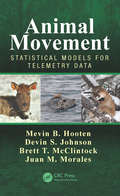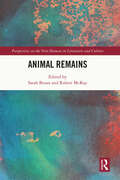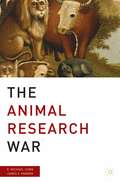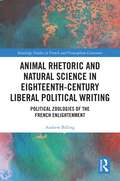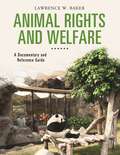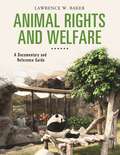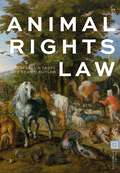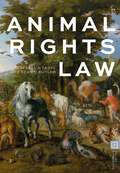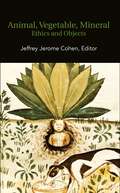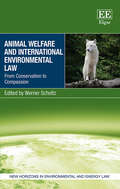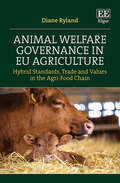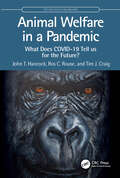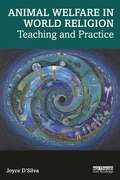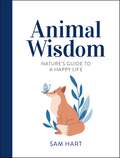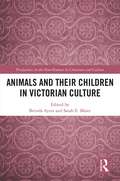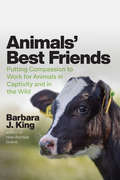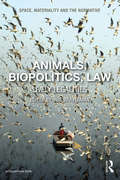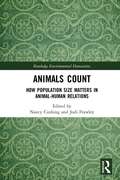- Table View
- List View
Animal Movement: Statistical Models for Telemetry Data
by Juan M. Morales Mevin B. Hooten Devin S. Johnson Brett T. McClintockThe study of animal movement has always been a key element in ecological science, because it is inherently linked to critical processes that scale from individuals to populations and communities to ecosystems. Rapid improvements in biotelemetry data collection and processing technology have given rise to a variety of statistical methods for characterizing animal movement. The book serves as a comprehensive reference for the types of statistical models used to study individual-based animal movement. Animal Movement is an essential reference for wildlife biologists, quantitative ecologists, and statisticians who seek a deeper understanding of modern animal movement models. A wide variety of modeling approaches are reconciled in the book using a consistent notation. Models are organized into groups based on how they treat the underlying spatio-temporal process of movement. Connections among approaches are highlighted to allow the reader to form a broader view of animal movement analysis and its associations with traditional spatial and temporal statistical modeling. After an initial overview examining the role that animal movement plays in ecology, a primer on spatial and temporal statistics provides a solid foundation for the remainder of the book. Each subsequent chapter outlines a fundamental type of statistical model utilized in the contemporary analysis of telemetry data for animal movement inference. Descriptions begin with basic traditional forms and sequentially build up to general classes of models in each category. Important background and technical details for each class of model are provided, including spatial point process models, discrete-time dynamic models, and continuous-time stochastic process models. The book also covers the essential elements for how to accommodate multiple sources of uncertainty, such as location error and latent behavior states. In addition to thorough descriptions of animal movement models, differences and connections are also emphasized to provide a broader perspective of approaches.
Animal Remains (Perspectives on the Non-Human in Literature and Culture)
by Sarah Bezan Robert McKayThe dream of humanism is to cleanly discard of humanity’s animal remains along with its ecological embeddings, evolutionary heritages and futures, ontogenies and phylogenies, sexualities and sensualities, vulnerabilities and mortalities. But, as the contributors to this volume demonstrate, animal remains are everywhere and so animals remain everywhere. Animal remains are food, medicine, and clothing; extractive resources and traces of animals’ lifeworlds and ecologies; they are sites of political conflict and ontological fear, fetishized visual signs and objects of trade, veneration and memory; they are biotechnological innovations, and spill-over viruses. To make sense of the material afterlives of animals, this book draws together multispecies perspectives from literary criticism and theory, cultural studies, anthropology and ethnography, photographic and film history, and contemporary art practice to offer the first synoptic account of animal remains. Interpreting them in all their ubiquity, diversity and persistence, Animal Remains reveals posthuman relations between human and nonhuman communities of the living and the dead, on timescales of decades, centuries, and millennia.
Animal Remains (Perspectives on the Non-Human in Literature and Culture)
by Sarah Bezan Robert McKayThe dream of humanism is to cleanly discard of humanity’s animal remains along with its ecological embeddings, evolutionary heritages and futures, ontogenies and phylogenies, sexualities and sensualities, vulnerabilities and mortalities. But, as the contributors to this volume demonstrate, animal remains are everywhere and so animals remain everywhere. Animal remains are food, medicine, and clothing; extractive resources and traces of animals’ lifeworlds and ecologies; they are sites of political conflict and ontological fear, fetishized visual signs and objects of trade, veneration and memory; they are biotechnological innovations, and spill-over viruses. To make sense of the material afterlives of animals, this book draws together multispecies perspectives from literary criticism and theory, cultural studies, anthropology and ethnography, photographic and film history, and contemporary art practice to offer the first synoptic account of animal remains. Interpreting them in all their ubiquity, diversity and persistence, Animal Remains reveals posthuman relations between human and nonhuman communities of the living and the dead, on timescales of decades, centuries, and millennia.
The Animal Research War
by P. Conn J. ParkerThis thoughtful and surprising book analyzes the effect of animal extremism on the world's scientists, their institutions, and professional societies. The Animal Research War traces the evolution of the animal rights movement, profiles its leadership, and reveals the truth behind university animal research.
Animal Rhetoric and Natural Science in Eighteenth-Century Liberal Political Writing: Political Zoologies of the French Enlightenment (Routledge Studies in French and Francophone Literature)
by Andrew BillingOur tendency to read French Enlightenment political writing from a narrow disciplinary perspective has obscured the hybrid character of political philosophy, rhetoric, and natural science in the period. As Michèle Duchet and others have shown, French Enlightenment thinkers developed a philosophical anthropology to support new political norms and models. This book explores how five important eighteenth-century French political authors—Rousseau, Diderot, La Mettrie, Quesnay, and Rétif de La Bretonne—also constructed a "political zoology" in their philosophical and literary writings informed by animal references drawn from Enlightenment natural history, science, and physiology. Drawing on theoretical work by Derrida, Latour, de Fontenay, and others, it shows how these five authors signed on to the old rhetorical tradition of animal comparisons in political philosophy, which they renewed via the findings and speculations of contemporary science. Engaging with recent scholarship on Enlightenment political thought, it also explores the links between their political zoologies and their family resemblance as "liberal" political thinkers.
Animal Rhetoric and Natural Science in Eighteenth-Century Liberal Political Writing: Political Zoologies of the French Enlightenment (Routledge Studies in French and Francophone Literature)
by Andrew BillingOur tendency to read French Enlightenment political writing from a narrow disciplinary perspective has obscured the hybrid character of political philosophy, rhetoric, and natural science in the period. As Michèle Duchet and others have shown, French Enlightenment thinkers developed a philosophical anthropology to support new political norms and models. This book explores how five important eighteenth-century French political authors—Rousseau, Diderot, La Mettrie, Quesnay, and Rétif de La Bretonne—also constructed a "political zoology" in their philosophical and literary writings informed by animal references drawn from Enlightenment natural history, science, and physiology. Drawing on theoretical work by Derrida, Latour, de Fontenay, and others, it shows how these five authors signed on to the old rhetorical tradition of animal comparisons in political philosophy, which they renewed via the findings and speculations of contemporary science. Engaging with recent scholarship on Enlightenment political thought, it also explores the links between their political zoologies and their family resemblance as "liberal" political thinkers.
Animal Rights and Welfare: A Documentary and Reference Guide (Documentary and Reference Guides)
by Lawrence W. BakerThrough the use of primary source documents, readers can learn about key opinions and legislation in the important field of animal rights and welfare—a current and highly relevant topic.Animal Rights and Welfare: A Documentary and Reference Guide addresses a broad range of key topics within the subject of animal rights and welfare, including zoos, animal testing, philosophy regarding the treatment of animals, and practical measures instituted to protect animals, supplying readers with an impartial and authoritative resource for understanding the history of animal rights and the issues that dominate discussions about animal rights. Organized chronologically, the book discusses topics such as animal rights within the context of hunting for food, pelts, and other body parts, as well as for recreation; working animals; animals used for education or scientific and medical research; animals in the fashion and entertainment industries; and the food industry.The text provides reproductions of dozens of carefully selected primary documents from the time of Aristotle (B.C.) to present day to engage readers and provide opportunities for them to apply their critical thinking and analysis skills. The text of each document is introduced by a headnote to place it in context and concludes with analysis that details its significance and clarifies specific passages when needed. Each document or excerpt is followed by a full citation of the document.
Animal Rights and Welfare: A Documentary and Reference Guide (Documentary and Reference Guides)
by Lawrence W. BakerThrough the use of primary source documents, readers can learn about key opinions and legislation in the important field of animal rights and welfare—a current and highly relevant topic.Animal Rights and Welfare: A Documentary and Reference Guide addresses a broad range of key topics within the subject of animal rights and welfare, including zoos, animal testing, philosophy regarding the treatment of animals, and practical measures instituted to protect animals, supplying readers with an impartial and authoritative resource for understanding the history of animal rights and the issues that dominate discussions about animal rights. Organized chronologically, the book discusses topics such as animal rights within the context of hunting for food, pelts, and other body parts, as well as for recreation; working animals; animals used for education or scientific and medical research; animals in the fashion and entertainment industries; and the food industry.The text provides reproductions of dozens of carefully selected primary documents from the time of Aristotle (B.C.) to present day to engage readers and provide opportunities for them to apply their critical thinking and analysis skills. The text of each document is introduced by a headnote to place it in context and concludes with analysis that details its significance and clarifies specific passages when needed. Each document or excerpt is followed by a full citation of the document.
Animal Rights Law
by Raffael N Fasel Sean C ButlerDo animals have legal rights? This pioneering book tells readers everything they need to know about animal rights law.Using straightforward examples from over 30 legal systems from both the civil and common law traditions, and based on popular courses run by the authors at the Cambridge Centre for Animal Rights, the book takes the reader from the earliest anti-cruelty laws to modern animal welfare laws, to recent attempts to grant basic rights and personhood to animals. To help readers understand this legal evolution, it explains the ethics, legal theory, and social issues behind animal rights and connected topics such as property, subjecthood, dignity, and human rights. The book's companion website (bloomsbury.pub/animal-rights-law) provides access to briefs on the latest developments in this fast-changing area, and gives readers the tools to investigate their own legal systems with a list of key references to the latest cases, legislation, and jurisdiction-specific bibliographic references.Rich in exercises and study aids, this easy-to-use introduction is a prime resource for students from all disciplines and for anyone else who wants to understand how animals are protected by the law.
Animal Rights Law
by Raffael N Fasel Sean C ButlerDo animals have legal rights? This pioneering book tells readers everything they need to know about animal rights law.Using straightforward examples from over 30 legal systems from both the civil and common law traditions, and based on popular courses run by the authors at the Cambridge Centre for Animal Rights, the book takes the reader from the earliest anti-cruelty laws to modern animal welfare laws, to recent attempts to grant basic rights and personhood to animals. To help readers understand this legal evolution, it explains the ethics, legal theory, and social issues behind animal rights and connected topics such as property, subjecthood, dignity, and human rights. The book's companion website (bloomsbury.pub/animal-rights-law) provides access to briefs on the latest developments in this fast-changing area, and gives readers the tools to investigate their own legal systems with a list of key references to the latest cases, legislation, and jurisdiction-specific bibliographic references.Rich in exercises and study aids, this easy-to-use introduction is a prime resource for students from all disciplines and for anyone else who wants to understand how animals are protected by the law.
Animal, Vegetable, Mineral: Ethics and Objects
by Jeffrey Jerome CohenAnimal, Mineral, Vegetable examines what happens when we cease to assume that only humans exert agency. Through a careful examination of medieval, early modern and contemporary lifeworlds, these essays collectively argue against ecological anthropocentricity. Sheep, wolves, camels, flowers, chairs, magnets, landscapes, refuse and gems are more than mere objects. They act; they withdraw; they make demands; they connect within lively networks that might foster a new humanism, or that might proceed with indifference towards human affairs. Through what ethics do we respond to these activities and forces? To what futures do these creatures and objects invite us, especially when they appear within the texts and cultures of the “distant” past?
Animal Welfare and International Environmental Law: From Conservation to Compassion (New Horizons in Environmental and Energy Law series)
by Werner ScholtzAt a time when the planet’s wildlife faces countless dangers, international environmental law continues to overlook its evolving welfare interests. This thought-provoking book provides a crucial exploration of how international environmental law must adapt to take account of the growing recognition of the intrinsic value of wildlife. Animal Welfare and International Environmental Law offers compelling and timely arguments in favour of wildlife’s inherent worth and proposes a progressive development of the law in response to its needs and interests. Taking into account recent trends in bioethics and conservation, these critical discussions of wildlife welfare have dramatic implications for the future of sustainable development and sustainable use. The book challenges assumptions by taking a perspective which decentres the needs of humans and instead emphasises the growing need to protect wildlife with compassion and care. This book will prove invaluable to both students and scholars of environmental law, animal law and international law more widely. It will also appeal to policymakers, legal scholars and NGOs dealing with the imminent needs of the earth’s wildlife.
Animal Welfare Governance in EU Agriculture: Hybrid Standards, Trade and Values in the Agri-Food Chain
by Diane RylandThis ground-breaking book sets out a comprehensive governance framework to raise the welfare of animals across EU agriculture and the agri-food chain. Diane Ryland argues that a global response is needed to promote animal wellbeing in agriculture, focusing on the importance of the relations between standard-setting bodies.Through a comparative analysis of major animal welfare standards, this book develops a transnational soft law hybrid governance model for animal welfare in agriculture. It examines, critically, animal welfare standards in the public and private spheres, investigating the links between the two and how they can be advanced. Drawing on extensive case studies, chapters explore animal welfare comprehensively for specific species and at various stages, in EU agriculture and the food supply chain. Ultimately, Ryland shows that concerned and informed consumers will be the drivers of change for effective global animal law.Animal Welfare Governance in EU Agriculture will be an invaluable resource for students and scholars in animal law, environmental law, regulation and governance, standardisation, and agricultural economics. It will also be an essential guide for activists and policymakers interested in improving the welfare of animals raised and traded in agriculture.
Animal Welfare in a Pandemic: What Does COVID-19 Tell us for the Future? (CRC One Health One Welfare)
by John T. Hancock Ros C. Rouse Tim J. CraigAnimal Welfare in a Pandemic explores the impact of COVID-19 on a wide array of animals, from those in the wild to companion and captive animals. During the height of the pandemic, a range of animals were infected, and many died, but this was hard to predict, even using up-to-date bioinformatics. Lockdowns around the world had, and continue to have, a major effect on animals’ welfare, influencing pet ownership and care, as well as impacting on the work of conservation institutes due to the lack of visitors and funding and lack of tourist presence in the wild which impacted on anti-poaching efforts. Some of the vast amount of personal protection equipment (PPE) that was distributed was discarded, creating both dangers and occasional opportunities for wild animals. With the rollout of human vaccines, some countries started developing animal vaccines, only some of which were deployed. In summary, the pandemic had a wide-ranging influence on animal welfare around the world. This is reviewed to highlight what can be learned to protect and enhance animal welfare in future epidemics/pandemics, and contribute to a genuinely One Health approach where the health and welfare of both humans and animals are considered holistically.This book is authored by members of the University of the West of England, Bristol, who span a range of expertise in Biological Sciences, Social Sciences, Animal Welfare, and Ethics.
Animal Welfare in a Pandemic: What Does COVID-19 Tell us for the Future? (CRC One Health One Welfare)
by John T. Hancock Ros C. Rouse Tim J. CraigAnimal Welfare in a Pandemic explores the impact of COVID-19 on a wide array of animals, from those in the wild to companion and captive animals. During the height of the pandemic, a range of animals were infected, and many died, but this was hard to predict, even using up-to-date bioinformatics. Lockdowns around the world had, and continue to have, a major effect on animals’ welfare, influencing pet ownership and care, as well as impacting on the work of conservation institutes due to the lack of visitors and funding and lack of tourist presence in the wild which impacted on anti-poaching efforts. Some of the vast amount of personal protection equipment (PPE) that was distributed was discarded, creating both dangers and occasional opportunities for wild animals. With the rollout of human vaccines, some countries started developing animal vaccines, only some of which were deployed. In summary, the pandemic had a wide-ranging influence on animal welfare around the world. This is reviewed to highlight what can be learned to protect and enhance animal welfare in future epidemics/pandemics, and contribute to a genuinely One Health approach where the health and welfare of both humans and animals are considered holistically.This book is authored by members of the University of the West of England, Bristol, who span a range of expertise in Biological Sciences, Social Sciences, Animal Welfare, and Ethics.
Animal Welfare in World Religion: Teaching and Practice
by Joyce D'SilvaThis unique and readable book examines the relationship between religion and animal welfare, taking a detailed dive into the teachings and practices of the major world religions. While there are many books expounding the beliefs of the major religions and many about the rights and welfare of animals, there are few linking the two. With each chapter focusing on one of the five major religions – Judaism, Christianity, Islam, Hinduism and Buddhism – the book explores the beliefs and practices which drive our relationship with and treatment of animals. The book draws on the scriptures of the major faiths and includes the voices of leading historical religious figures and contemporary faith leaders. In doing so, it compares the teachings of old with contemporary practices and showcases the impact of the major religions on both the protection and exploitation of animals, from running animal sanctuaries, to participating in or condoning cruel sports and factory farming. Importantly, the book also includes a chapter looking beyond the major world religions, where it examines a wider range of beliefs and practices, including Indigenous peoples from the USA and Australia, Jainism, Sikhism and Rastafarianism, to provide fascinating insights into another range of beliefs and views on the human-animal relationship. Overall, this book challenges and encourages religious leaders and followers to re-examine their teachings and to prioritise the well-being of animals. This book is essential reading for those interested in the role of religion in animal welfare, human-animal studies, and animal welfare and ethics more broadly.
Animal Welfare in World Religion: Teaching and Practice
by Joyce D'SilvaThis unique and readable book examines the relationship between religion and animal welfare, taking a detailed dive into the teachings and practices of the major world religions. While there are many books expounding the beliefs of the major religions and many about the rights and welfare of animals, there are few linking the two. With each chapter focusing on one of the five major religions – Judaism, Christianity, Islam, Hinduism and Buddhism – the book explores the beliefs and practices which drive our relationship with and treatment of animals. The book draws on the scriptures of the major faiths and includes the voices of leading historical religious figures and contemporary faith leaders. In doing so, it compares the teachings of old with contemporary practices and showcases the impact of the major religions on both the protection and exploitation of animals, from running animal sanctuaries, to participating in or condoning cruel sports and factory farming. Importantly, the book also includes a chapter looking beyond the major world religions, where it examines a wider range of beliefs and practices, including Indigenous peoples from the USA and Australia, Jainism, Sikhism and Rastafarianism, to provide fascinating insights into another range of beliefs and views on the human-animal relationship. Overall, this book challenges and encourages religious leaders and followers to re-examine their teachings and to prioritise the well-being of animals. This book is essential reading for those interested in the role of religion in animal welfare, human-animal studies, and animal welfare and ethics more broadly.
Animal Wisdom: Nature's Guide to a Happy Life
by Sam HartSelf-care gone wild Slow down like a sloth, stretch like a cat, breathe deep like a whale and have the confidence of a lion. When life gets you down, lift your spirits with these tiny tips and helpful hints from our friends in the animal kingdom.
Animals and Their Children in Victorian Culture (Perspectives on the Non-Human in Literature and Culture)
by Brenda Ayres Sarah Elizabeth MaierWhether a secularized morality, biblical worldview, or unstated set of mores, the Victorian period can and always will be distinguished from those before and after for its pervasive sense of the "proper way" of thinking, speaking, doing, and acting. Animals in literature taught Victorian children how to be behave. If you are a postmodern posthumanist, you might argue, "But the animals in literature did not write their own accounts." Animal characters may be the creations of writers’ imagination, but animals did and do exist in their own right, as did and do humans. The original essays in Animals and Their Children in Victorian explore the representation of animals in children’s literature by resisting an anthropomorphized perception of them. Instead of focusing on the domestication of animals, this book analyzes how animals in literature "civilize" children, teaching them how to get along with fellow creatures—both human and nonhuman.
Animals and Their Children in Victorian Culture (Perspectives on the Non-Human in Literature and Culture)
by Brenda Ayres Sarah Elizabeth MaierWhether a secularized morality, biblical worldview, or unstated set of mores, the Victorian period can and always will be distinguished from those before and after for its pervasive sense of the "proper way" of thinking, speaking, doing, and acting. Animals in literature taught Victorian children how to be behave. If you are a postmodern posthumanist, you might argue, "But the animals in literature did not write their own accounts." Animal characters may be the creations of writers’ imagination, but animals did and do exist in their own right, as did and do humans. The original essays in Animals and Their Children in Victorian explore the representation of animals in children’s literature by resisting an anthropomorphized perception of them. Instead of focusing on the domestication of animals, this book analyzes how animals in literature "civilize" children, teaching them how to get along with fellow creatures—both human and nonhuman.
Animals' Best Friends: Putting Compassion to Work for Animals in Captivity and in the Wild
by Barbara J. KingAs people come to understand more about animals’ inner lives—the intricacies of their thoughts and the emotions that are expressed every day by whales and cows, octopus and mice, even bees—we feel a growing compassion, a desire to better their lives. But how do we translate this compassion into helping other creatures, both those that are and are not our pets? Bringing together the latest science with heartfelt storytelling, Animals’ Best Friends reveals the opportunities we have in everyday life to help animals in our homes, in the wild, in zoos, and in science labs, as well as those considered to be food. Barbara J. King, an expert on animal cognition and emotion, guides us on a journey both animal and deeply human. We meet cows living relaxed lives in an animal sanctuary—and cows with plastic portals in their sides at a university research station. We observe bison free-roaming at Yellowstone National Park and chimpanzees confined to zoos. We learn with King how to negotiate vegetarian preferences in omnivore restaurants. We experience the touch of a giant Pacific octopus tasting King’s skin with one of his long, neuron-rich arms. We reflect on animal testing as King shares her own experience as the survivor of a particularly nasty cancer. And in a moment all too familiar to many of us, we recover from a close encounter with two spiders in the home. This is a book not of shaming and limitation, but of uplift and expansion. Throughout this journey, King makes no claims of personal perfection. Though an animal expert, she is just like the rest of us: on a journey still, learning each day how to be better, and do better, for animals. But as Animals’ Best Friends makes clear, challenging choices can bring deep rewards. By turning compassion into action on behalf of animals, we not only improve animals’ lives—we also immeasurably enrich our own.
Animals' Best Friends: Putting Compassion to Work for Animals in Captivity and in the Wild
by Barbara J. KingAs people come to understand more about animals’ inner lives—the intricacies of their thoughts and the emotions that are expressed every day by whales and cows, octopus and mice, even bees—we feel a growing compassion, a desire to better their lives. But how do we translate this compassion into helping other creatures, both those that are and are not our pets? Bringing together the latest science with heartfelt storytelling, Animals’ Best Friends reveals the opportunities we have in everyday life to help animals in our homes, in the wild, in zoos, and in science labs, as well as those considered to be food. Barbara J. King, an expert on animal cognition and emotion, guides us on a journey both animal and deeply human. We meet cows living relaxed lives in an animal sanctuary—and cows with plastic portals in their sides at a university research station. We observe bison free-roaming at Yellowstone National Park and chimpanzees confined to zoos. We learn with King how to negotiate vegetarian preferences in omnivore restaurants. We experience the touch of a giant Pacific octopus tasting King’s skin with one of his long, neuron-rich arms. We reflect on animal testing as King shares her own experience as the survivor of a particularly nasty cancer. And in a moment all too familiar to many of us, we recover from a close encounter with two spiders in the home. This is a book not of shaming and limitation, but of uplift and expansion. Throughout this journey, King makes no claims of personal perfection. Though an animal expert, she is just like the rest of us: on a journey still, learning each day how to be better, and do better, for animals. But as Animals’ Best Friends makes clear, challenging choices can bring deep rewards. By turning compassion into action on behalf of animals, we not only improve animals’ lives—we also immeasurably enrich our own.
Animals, Biopolitics, Law: Lively Legalities
by Irus BravermanTypically, the legal investigation of nonhuman life, and of animal life in particular, is conducted through the discourse of animal rights. Within this discourse, legal rights are extended to certain nonhuman animals through the same liberal framework that has afforded human rights before it. Animals, Biopolitics, Law envisions the possibility of lively legalities that move beyond the humanist perspective. Drawing on an array of expertise—from law, geography, and anthropology, through animal studies and posthumanism, to science and technology studies—this interdisciplinary collection asks what, in legal terms, it means to be human and nonhuman, what it means to govern and to be governed, and what are the ethical and political concerns that emerge in the project of governing not only human but also more-than-human life.
Animals, Biopolitics, Law: Lively Legalities
by Irus BravermanTypically, the legal investigation of nonhuman life, and of animal life in particular, is conducted through the discourse of animal rights. Within this discourse, legal rights are extended to certain nonhuman animals through the same liberal framework that has afforded human rights before it. Animals, Biopolitics, Law envisions the possibility of lively legalities that move beyond the humanist perspective. Drawing on an array of expertise—from law, geography, and anthropology, through animal studies and posthumanism, to science and technology studies—this interdisciplinary collection asks what, in legal terms, it means to be human and nonhuman, what it means to govern and to be governed, and what are the ethical and political concerns that emerge in the project of governing not only human but also more-than-human life.
Animals Count: How Population Size Matters in Animal-Human Relations (Routledge Environmental Humanities)
by Nancy Cushing Jodi FrawleyWhether their populations are perceived as too large, just right, too small or non-existent, animal numbers matter to the humans with whom they share environments. Animals in the right numbers are accepted and even welcomed, but when they are seen to deviate from the human-declared set point, they become either enemies upon whom to declare war or victims to be protected. In this edited volume, leading and emerging scholars investigate for the first time the ways in which the size of an animal population impacts how they are viewed by humans and, conversely, how human perceptions of populations impact animals. This collection explores the fortunes of amphibians, mammals, insects and fish whose numbers have created concern in settler Australia and examines shifts in these populations between excess, abundance, equilibrium, scarcity and extinction. The book points to the importance of caution in future campaigns to manipulate animal populations, and demonstrates how approaches from the humanities can be deployed to bring fresh perspectives to understandings of how to live alongside other animals.
